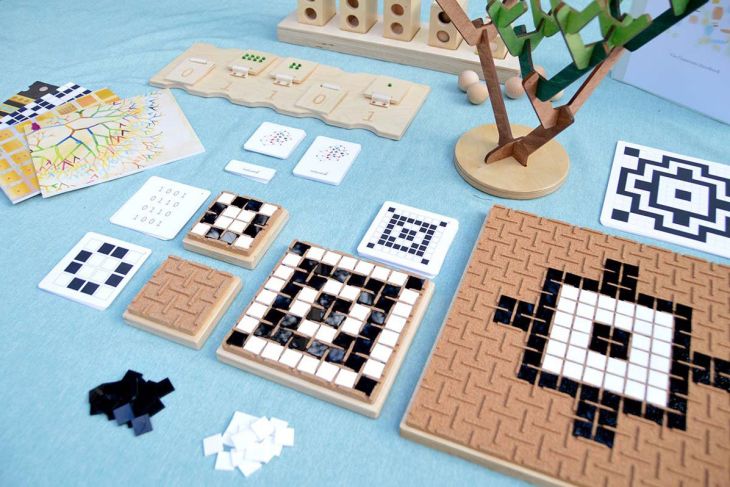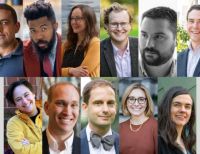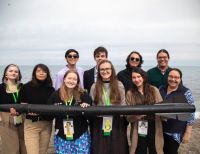People at MIT know “mens et manus,” or “mind and hand,” as the school motto. But it’s also a good framework for early childhood education. Kids often learn best when they’re allowed to explore the environment around them, building models of the world by picking things up and moving them around.
Back in 2014, that insight was the inspiration for a Media Lab project that designed new learning environments. Four years later, that project became the inspiration for a startup called Learning Beautiful.
Learning Beautiful makes tactile materials to inspire hands-on learning for kids between the ages of 3 and 9. The materials, which are designed to explain simple concepts in computer science, promote child-driven, physical learning that aligns with the Montessori method of education.
“For young children, being able to build and then experience with their hands is so important,” Learning Beautiful founder Kim Smith Claudel SM ’17 says. “I don’t think I need to do much convincing about the importance of limiting screen time for kids. I focus more on the positive things we can give to children, and I think giving them these sensorial, tactile materials is a developmentally enriching opportunity.”
The company’s materials include things like binary cards and pixel boards made from sustainably sourced wood, cork, and canvas. To date, Learning Beautiful has sold over 2,000 materials to schools and libraries and trained about 500 teachers to guide learning activities.
Smith Claudel believes the concepts illuminated by the materials are a great primer to more advanced computer science education later in life.
“If we think about how we scaffold learning for subjects like reading and writing and math, we have all these things in place to build a strong foundation in early childhood to help progression in these subjects,” Smith Claudel says. “But there really wasn’t something that did the same thing for computer science.”
From project to product
In 2013, Smith Claudel began collaborating with Sepandar Kamvar, who was a professor of media arts and sciences at MIT and the director of the Social Computing group at the Media Lab. After Smith Claudel worked on a show Kamvar was organizing in Sweden, he asked her to join his lab as a research scientist.
“His vision was to bring together a lot of different people,” Smith Claudel recalls. “My background was art and design, and we had architects, computer scientists, videographers, biologists, educators, and philosophers.”
The diverse team soon began exploring alternative approaches to education, partially inspired by Kamvar’s own struggles to find a good prekindergarten school for his child. Their ideas coalesced into the first of what the team called “Wildflower Schools” described as open-source learning environments inspired by the century-old Montessori learning method that emphasizes self-directed learning activities based on children’s natural interests.
The schools served as test beds for experiments in teaching and learning, with the project advertised as “blurring the boundaries between home-schooling and institutional schooling, between scientists and teachers, between schools and the neighborhoods around them.”
“I worked in the school for a year doing art projects with the kids, and that was my crash course in Montessori education,” Smith Claudel says.
The first school sparked interest in the Cambridge community, so the group opened more. Each one featured aspects of the research going on in Kamvar’s lab, including small-scale agriculture projects and experiments with different learning materials — even some of the teachers were members of the lab.
“The idea was to test different things with the community and cultivate this research within the school,” Smith Claudel says. “It became a link to what we were doing in the Media Lab.”
Smith Claudel became enamored with some of the materials being used in the classrooms and intrigued by the research showing young children learn more effectively by physically interacting with their environment. She officially enrolled in the Media Lab as a graduate student in 2015.
After hearing frustration from MIT computer scientists that too many educational materials were screen-based and focused solely on coding, Smith Claudel and others in her lab worked with them to build materials that demonstrated different computational concepts.
“The children are very helpful because it either works or it doesn’t work,” Smith Claudel says. “Feedback from teachers is also helpful because either they understand it or they don’t, and if they don’t then we’ve failed.”
Smith Claudel went through the MIT DesignX accelerator run through the School of Architecture, where they started hearing from people who wanted copies of their research materials for their classrooms and libraries.
“DesignX shifted the whole paradigm of how I thought about the research, and turned it into ‘How can we take this solid foundation and spin it into a business?’” Smith Claudel says.
As Smith Claudel neared graduation in 2017, she got her first order for materials from the Chicago Public Library, which had seen her work develop at the Media Lab. She still remembers juggling finishing her master’s work with building each of those early sets by hand in MIT’s makerspaces, using CNC machines and spending hours sanding, painting, and gluing.
The company’s first series of materials includes pixel boards that demonstrate how computers represent images through 1s and 0s and a “binary tree” that introduces the concept of data structures as the child connects the branches and builds the tree.
“With the binary tree, a 2- or 3-year-old might start playing using what we call sensorial exploration,” Smith Claudel says. “What they’re doing is experimenting and discovering through a physical process. They’re starting to see things fit together. They’re starting to build something, getting a sense of balance. They’re also noticing the pieces are different shapes, different colors, so they’re building these models. They’re learning from that whole process.”
Learning Beautiful also provides support and educational materials for teachers.
“We learned early on you can’t just hand someone new materials and expect them to be comfortable with an unfamiliar subject area, so we created children’s books, a full curriculum, lesson plans, and then training,” Smith Claudel says.
When school shut down during the pandemic, the team developed instructions for at-home learning activities and offered them for free to parents and teachers. The slowdown also gave them time to plan their next series of materials, which will be released over the next year.
“A pause can be a healthy thing,” Smith Claudel says. “Especially in the beginning [of the pandemic], our attitude was what could we make that would be helpful right now?”
Helping everyone learn beautiful
Lately the company has been focusing on scaling its teacher training efforts, including by building a virtual training program.
Last fall, after partnering with a school district in Iowa, Learning Beautiful hosted a training workshop with 250 teachers, giving them each their own set of materials to bring back to their classrooms.
Smith Claudel also believes her materials can help a broader set of children than computer-based learning programs. Learning Beautiful has even begun conversations with schools in other countries that don’t have access to electricity.
“I think accessibility is really important on a few different levels,” Smith Claudel says. “We all learn differently, so to provide a variety of different kinds of learning opportunities is crucial. We use sound and touch in our materials, and we’ve had early conversations about working with blind children, because the materials are not solely dependent on sight.”
Learning Beautiful’s next products will expand beyond computer science to encourage ecological thinking, helping children understand environmental systems around them and their schools.
As the company’s sales grow, it’s developed a program where proceeds from sales to one community can help fund donations to communities with fewer resources.
“Hands-on learning is effective for all of us,” Smith Claudel says. “For children, most of their brain development is happening between zero and three, so physical interaction is so rich — understanding spatial relationships, how to hold things, how to use their body, how to take inputs from the world and process them in their minds. That’s what MIT’s ‘mind and hand’ motto is about: this connection between the physical experiences and what we’re building in our mind.”
















